Pet acquisition
The most common places for people to get their dogs, cats and rabbits from have remained largely the same over the last 12 years of PAW Report data. Dog owners were most likely to get their pets from a breeder (32%), cat owners from a UK rescue centre rehoming UK pets (27%) and rabbit owners from a pet shop or garden centre (32%).
However, there have been some changes within the data, particularly around the proportion of owners who got their pet from a UK rescue centre rehoming UK pets. The proportion of dog owners who acquired their pet from this source has decreased from 18% in February 2020 to 14% in 2022. Similarly, the proportion of cat owners who acquired their cat from a UK rescue centre for UK cats has fallen from 35% in Aug 2020 to 27% in 2022, and for rabbit owners, the proportion has decreased from 19% in August 2020 to 14% in 2022.
The proportion of owners getting their pet from a breeder (based in the UK or abroad, of single or multiple breeds) has fluctuated for dogs over the last five years but neither increased or decreased overall (32% in 2022), and remained stable for cats and rabbits over the same time period (14% and 7% respectively in 2022).
New* owners were more likely to have acquired their pet from a private seller (20%) or UK based breeder of one specific breed (17%) and less likely to get from a UK rescue centre for UK pets (17%) compared to owners who did not describe themselves as new (17%, 15% and 23% respectively).
How owners acquired their pets
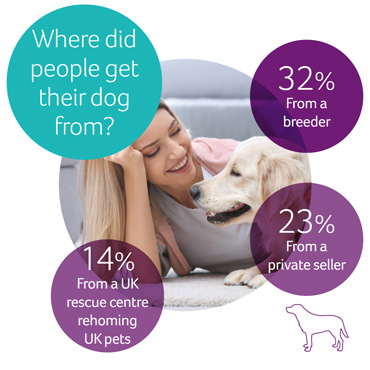
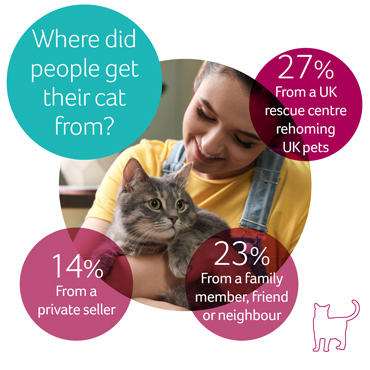
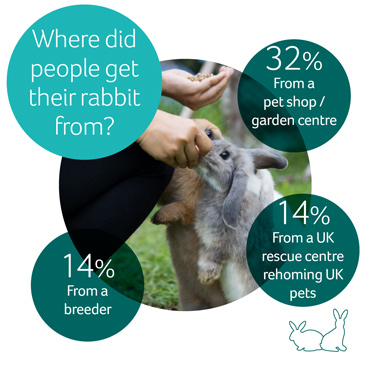
Owners getting pets from abroad
The proportion of pets coming from abroad has continued to increase in 2022, with 6% of owners telling us that their pet was imported compared to 4% in 2021 and 3% in August 2020. The increase is across all three species, but is particularly marked in cats and rabbits. One concern this raises is an increased risk of the importation of exotic diseases and parasites such as heartworm, leishmania, brucellosis and babesiosis7,8,9.
The proportion of dogs acquired from abroad has increased from 4% in August 2020 to 6% in 2021 and 6% in 2022, equating to 640,000 imported dogs in 2022. This increase is largely due to dogs coming from UK rescue centres that are rehoming pets from abroad (1% in August 2020 to 3% in 2022), rescue and rehoming centres based abroad (1% in August 2020 to 2% in 2022) and breeders of multiple breeds who are based abroad (<1% in 2021 to 1% in 2022).
The proportion of cats acquired from abroad has increased from 2% in August 2020 and 1% in 2021 to 5% in 2022, equating to 590,000 imported cats in 2022. This increase has mostly been driven by an increase in cats being acquired from UK rescue centres that are rehoming pets from abroad (1% in August 2020, <1% in 2021, 3% in 2022).
The proportion of rabbits acquired from abroad has increased from 1% in 2021 to 3% in 2022, equating to 31,000 imported rabbits.
When we asked why owners had chosen to get their pet from abroad, the most common reason was that they had no preference where pet came from, they just happened to come from abroad (35%) – this was higher for dog owners at 48% than cat owners at 18%.
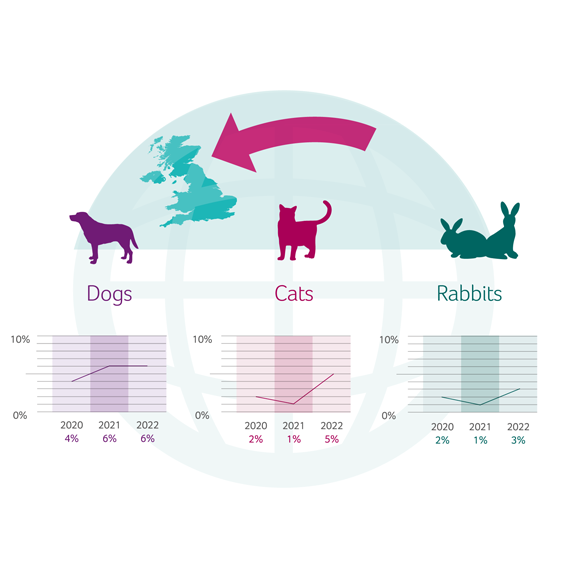
4% of dog owners who got their pet from abroad told us they did so because they wanted a dog with cropped ears, meaning that an estimated total of 26,000 dogs have been imported because their owners wanted them to have a cosmetic mutilation surgery that is illegal in this country. While this number appears vastly higher than in 2021, this is largely due to the overall increase in dog population. The proportion of dog owners who acquired their dog from abroad is not statistically different to 2021, nor is the proportion that imported because they wanted a dog with cropped ears. In addition, 3% of owners said they had imported because they wanted a dog with a docked tail (estimated 17,000 dogs).
An emerging issue appears to be that of cat declawing. Alarmingly, 5% of cat owners who got their cat from abroad, equating to 31,000 cats, told us that they chose to get their pet from abroad because they wanted them to be declawed. Scratching is a natural behaviour for cats, and surgically amputating their claws deprives them of this ability, as well as potentially leaving them with long-term pain issues10. We will continue to monitor this issue in order to inform the sector of emerging issues which teams need to be aware of and can work to tackle.
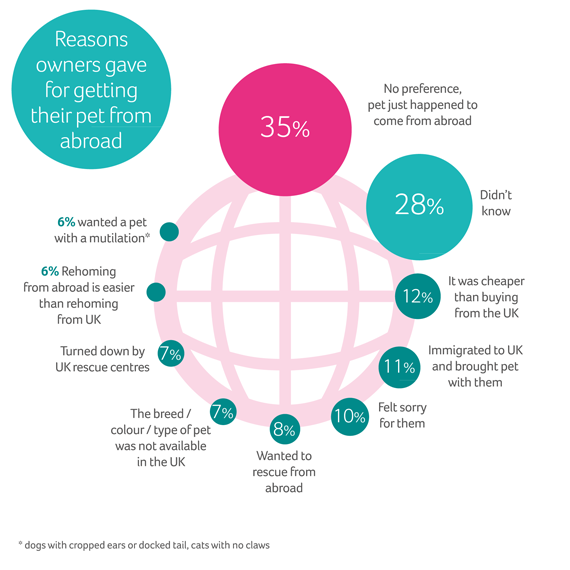
Click to see more details
What did owners do before getting their pet?
Prospective pet owners use the internet both as a source of information and as a place to find their new pet. 28% of owners told us that they looked on the internet before choosing their pet (34% of dog owners, 20% of cat owners, 32% of rabbit owners). 20% of owners said they didn’t do anything before choosing their pet, and only 6% took advice from a veterinary professional (9% for rabbit owners, 7% of dog owners and 5% of cat owners). This may reflect a lack of access to veterinary professionals, given the constraints on the veterinary industry over the last 2 years6, however the proportion is no different from when the question has been asked in previous years (7% in 2019, 6% in Feb 2020, 7% in August 2020). It is essential that owners and prospective owners can easily and readily access reliable, trustworthy sources of information on the internet.
53% of owners found their pet online, with a higher proportion of dog owners finding their pet this way (63% of dog owners compared to 45% of rabbit owners and 43% of cat owners). The most common online source for pets was dedicated websites, whether online advertising sites such as Gumtree or Pets4Homes (14% of pet owners – 19% of dogs, 9% of cats, 12% of rabbits), individual breeders’ websites (8% of pet owners – 13% of dogs, 3% of cats, 7% of rabbits) or rescue centres’ websites (15% of pet owners, 14% of dogs, 17% of cats, 11% of rabbits). This highlights the importance of the work that organisations like the Pet Advertising Advisory Group (PAAG) are doing to try to ensure that pet animals advertised for sale are done so legally and ethically. However, 5% of pet owners told us that they had found their pet on social media (e.g. Facebook, Instagram, Twitter, TikTok). Despite rules prohibiting such activity being in place on some of these platforms, the lack of any formal regulation and oversight of these channels means this is a concerning finding which we will continue to monitor.
Of those dog owners who acquired their pet from a breeder or private seller, 71% saw them with their mother but only 50% visited them on more than one occasion before taking them home. These are both important steps that can help owners to identify responsible breeders and avoid puppy farms.
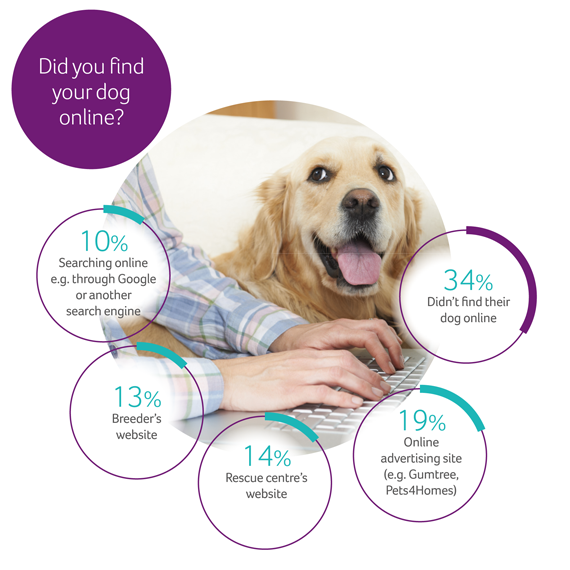
Click to expand
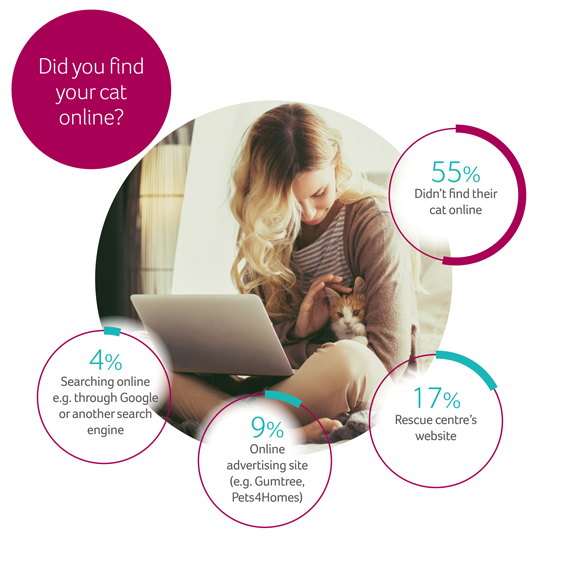
Click to expand
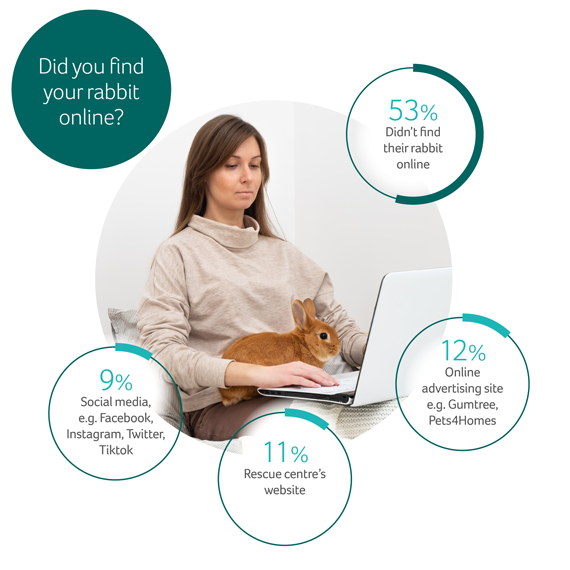
Click to expand
Hear from the Head of Companion Animals at RSPCA, Dr Sam Gaines
 Video found at youtu.be/IVQUCjKLTOw
Video found at youtu.be/IVQUCjKLTOw
Dr Sam Gaines, BSc, MSc, PhD, head of Companion Animals at RSPCA

Footnotes
*new owner defined as not having owned that species of pet before as an adult
7. Karasová, M., Tóthová, C., Grelová, S., & Fialkovičová, M. (2022). The Etiology, Incidence, Pathogenesis, Diagnostics, and Treatment of Canine Babesiosis Caused by Babesia gibsoni Infection. Animals, 12(6), 739.
8. McGarry, J. W., Carrozza, R., Bradley, C., Latrofa, M. S., Makepeace, B. L., & Otranto, D. (2022). Onchocerca lupi in imported dogs in the UK: implications for animal and public health. BMC Veterinary Research, 18(1), 1-4.
9. Drake, J. (2021). Dog Relocation and Rapidly Changing Parasite Threats. In Biology and Life Sciences Forum (Vol. 5, No. 1, p. 4). Multidisciplinary Digital Publishing Institute
10. Martell-Moran, N. K., Solano, M., & Townsend, H. G. (2018). Pain and adverse behavior in declawed cats. Journal of feline medicine and surgery, 20(4), 280-288.

